Graham Reid | | 4 min read
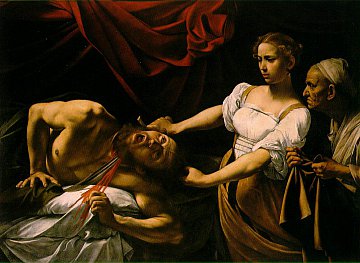
Few 17th century artists engage the modern audience in quite the same way as the man known as Caravaggio. He was, by contemporary accounts, an aggressive knife-carrying and swaggering figure, an innovative but volatile painter who spent time in prison for various assaults and profanities. Then – while painting some of the most exceptional work of his period – he murdered a young man (a feud sparked by a dispute over a fault in a tennis game) and was sentenced to death by the Pope. The papal edict allowed anyone encountering Caravaggio to take his life.
The artist went on the run. Not for the first time.
In his final years he painted five horrific visions of beheadings as if anticipating his own death by the hand of anyone who cared to do the same to him. He tried to get a pardon by painting his way to freedom, but he was also increasingly unbalanced – some suggest slow poisoning by the metals in his paint – but trouble followed him everywhere. While in Naples he was wounded in a fight and, his body weakened by the vicissitudes of his life and work, he slowed down.
Excitingly for the modern audience, the death of this charismatic genius is surrounded in mystery although it seems he was arrested in Palo Laziale near Rome -- even though he was on his way to the city to be pardoned – and so headed north and . . .
Bones of an artist of his age have recently been discovered in Porto Ercole.
Even before the end of his life in 1610 at the age of 38, Caravaggio's work was known, seen and admired in Milan, Genoa, Mantua, Malta, Sicily, France, Spain and Rome.
He was a star, albeit one whose hot temper and sexual conquests were as widely known as the paintings.
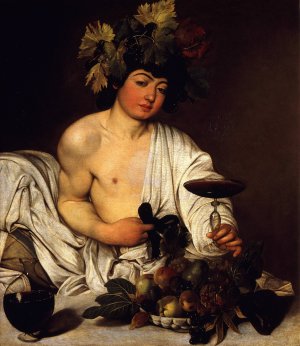 And, lest we forget the art by being
seduced by the man, there are his paintings: the youthful works of
that horrific and melodramatic head of the Medusa reflected in
Perseus' shield.
And, lest we forget the art by being
seduced by the man, there are his paintings: the youthful works of
that horrific and melodramatic head of the Medusa reflected in
Perseus' shield.
And the plump, mildly drunk and jaded Bacchus whose skin is decaying and as rotten as the fruit in the bowl beside him (both these in Florence's Uffizi).
And then those later works of utter brutality where figures emerge from or disappear into the anonymous blackness and there is an often chilling sense of interval between the solid space. Here, holding out a severed head of Goliath is David, then there are the astonishing and innovative Crucifixion of St Peter and the wonderful Conversion on the Way to Damascus on each side of the altarpiece in the marvellous Santa Maria del Populo in Rome.
Put ourselves back into Caravaggio's time and in the shadowy gloom of this candlelit chapel these figures would hover mysteriously, caught between the void beyond and the actual chapel space, inhabiting neither entirely but imbued with that mystical quality of occupying both.
It is possible to do – and I have done it – a fascinating self-guided tour of Rome just following Caravaggio's works.
Peter Robb's excellent and visceral biography M (Caravaggio – born Michelangelo Merisi in the twon of Caravaggio in 1571 – was sometimes referred to simply as that) is worth reading, and the artist has been the subject of documentaries by Robert Hughes and Simon Schama, and a film by Derek Jarman.
But those looking for the shorthand could simply tune in for the hour-long doco Caravaggio: Man and Mystery on the Arts Channel, Tuesday March 19, 9.20pm.
Man and Mystery – the title designed to have mass appeal and presented as an intelligent detective story following the discovery of those bones – is beautifully re-enacted with director of photography Maurizio Felli enjoying and indulging in a feel for the light and dark of the paintings, and the taverns or streets the artist inhabited.
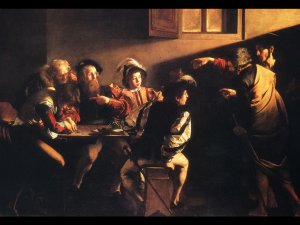 Caravaggio was more than just some
stroppy bad boy of Italian art (although he was undeniably that)
because his best paintings are masterpieces of light and dark,
penumbra and chiaroscuro. His painting of The Calling of St Matthew –
where a bold shaft of holy light from the right pierces the halflight
and illuminates the soon-to-be-saint – was as innovative as it was problemmatic in terms of "realism".
Caravaggio was more than just some
stroppy bad boy of Italian art (although he was undeniably that)
because his best paintings are masterpieces of light and dark,
penumbra and chiaroscuro. His painting of The Calling of St Matthew –
where a bold shaft of holy light from the right pierces the halflight
and illuminates the soon-to-be-saint – was as innovative as it was problemmatic in terms of "realism".
But the same man could also have Judith sawing away at the throat of Holofernes with cool determination while he gasps for breath and and hatchet-faced old woman looks on.
A gifted realist in his application of paint and colour, but vividly imaginative in his composition or interpretation of Biblical events, Caravaggio therefore is all the more interesting because his work is theatrical and psychological . . . and he controversially drew his models from real life.
Sometimes he used known prostitutes and low-life types as saints and holy figures (and included himself, sometimes almost invisibly, many times) to create a vivid but faux-realism.
How he achieved such realistic effects of light and texture is also explored in Man and Mystery. Camera obscura? A concave mirror? Or just observational genius and a sure hand?
In the end it hardly matters because what Caravaggio created was a splendid illusion which sometimes took us into the most horrific and bloody passages on the Bible as much as those which are morally uplifting.
Directed by Richard Blanshard and Marco Visalberghi, Caravaggio; Man and Mystery is a fascinating and informative shortcut into the world and works of a man who life was as intoxicatingly violent as it was touched by a rare gift, both of which the used against, and in the service of, faith and art.

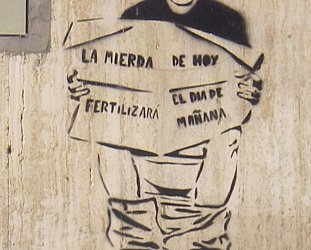
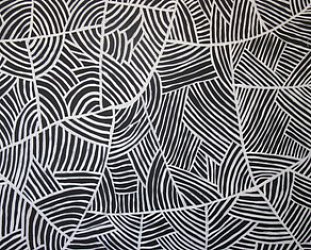

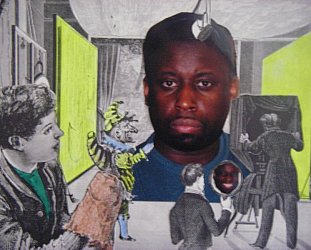
post a comment